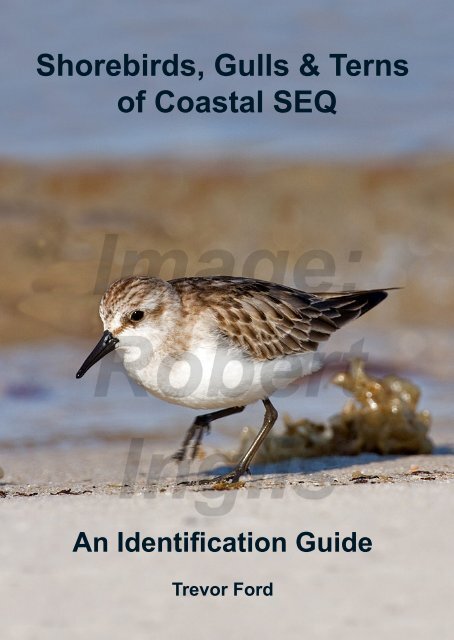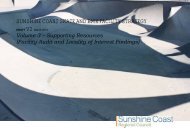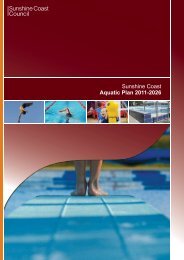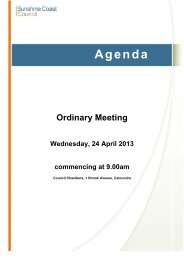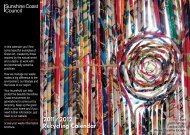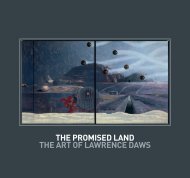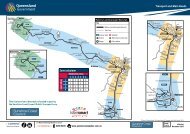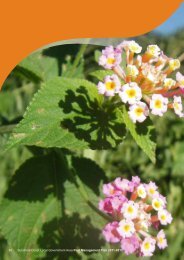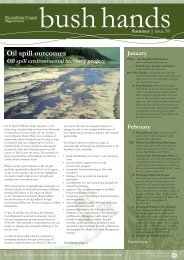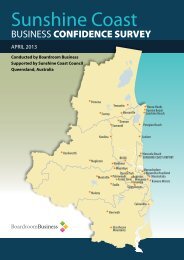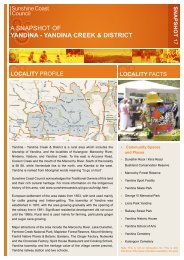Shorebirds, Gulls & Terns of Coastal SEQ - Sunshine Coast Council
Shorebirds, Gulls & Terns of Coastal SEQ - Sunshine Coast Council
Shorebirds, Gulls & Terns of Coastal SEQ - Sunshine Coast Council
Create successful ePaper yourself
Turn your PDF publications into a flip-book with our unique Google optimized e-Paper software.
<strong>Shorebirds</strong>, <strong>Gulls</strong> & <strong>Terns</strong><br />
<strong>of</strong> <strong><strong>Coast</strong>al</strong> <strong>SEQ</strong><br />
An Identification Guide<br />
Trevor Ford
Map <strong>of</strong> <strong><strong>Coast</strong>al</strong> <strong>SEQ</strong>
<strong>Shorebirds</strong>, <strong>Gulls</strong> & <strong>Terns</strong><br />
<strong>of</strong> <strong><strong>Coast</strong>al</strong> <strong>SEQ</strong><br />
R Inglis<br />
An Identification Guide<br />
Trevor Ford<br />
1
First published in 2010.<br />
This booklet, which has evolved from the brochure “Pumicestone Passage<br />
Shorebird Challenge & Identification Guide”, may not be produced or transmitted<br />
in whole or part, in any form, without prior permission from the author.<br />
Printed by Platypus Graphics, Stafford, Brisbane, Qld, with assistance and<br />
support from Victory Press, Bribie Island, Qld.<br />
The photograph <strong>of</strong> the Red-necked Stint on the front cover and the photograph<br />
<strong>of</strong> the roosting godwits on the back cover were taken by Robert Inglis. The<br />
photograph on page one is <strong>of</strong> two Little <strong>Terns</strong>.<br />
The <strong><strong>Coast</strong>al</strong> <strong>SEQ</strong> map, inside front cover, identifies the four funding councils.<br />
The flight identification guide, inside back cover, was devised by Trevor Ford.<br />
The East Asian-Australasian Flyway map below was designed by Sarah Mitchell.<br />
Migration Routes <strong>of</strong> the East Asian-Australasian Flyway<br />
2
Contents<br />
Page<br />
Introduction 4<br />
<strong>Shorebirds</strong> 4<br />
<strong>Gulls</strong> 5<br />
<strong>Terns</strong> 5<br />
Requirements 6<br />
Survival 7<br />
Birding locations 8<br />
<strong>Sunshine</strong> <strong>Coast</strong> 8<br />
Pumicestone Passage 9<br />
Moreton Bay 9<br />
Gold <strong>Coast</strong> 10<br />
Species identification 11<br />
Identification guide 11<br />
<strong>Shorebirds</strong> 12<br />
<strong>Gulls</strong> 54<br />
<strong>Terns</strong> 55<br />
Index <strong>of</strong> species 62<br />
Acknowledgements 64<br />
3
Introduction<br />
This booklet provides an introduction to the shorebirds, gulls<br />
and terns <strong>of</strong> coastal South East Queensland (<strong>SEQ</strong>), outlining<br />
their diverse requirements and some <strong>of</strong> the problems they face<br />
for survival. There is also an overview <strong>of</strong> several <strong>of</strong> the most<br />
important and easily-accessible sites where these birds may<br />
be seen. The main section <strong>of</strong> the booklet is an identification<br />
guide that describes the shorebirds, gulls and terns that are<br />
most likely to be encountered in the region. Hopefully, by<br />
raising general awareness <strong>of</strong> these truly remarkable birds,<br />
problems confronting them in the future will be met with positive<br />
responses and decisive action.<br />
<strong>Shorebirds</strong><br />
<strong>Shorebirds</strong>, or waders, range in size from the tiny Red-necked<br />
Stint to the extremely large Eastern Curlew, and over fifty<br />
species occur regularly in Australia. They generally live in<br />
inter-tidal areas or freshwater wetlands, spending most <strong>of</strong> their<br />
time close to water, although some species, such as Masked<br />
Lapwing, prefer fields and grasslands.<br />
About one-third <strong>of</strong> all Australian shorebirds are year-round<br />
residents, whereas the other two-thirds are visitors. Most <strong>of</strong><br />
these visitors are long-distance migrants from their breeding<br />
grounds in the northern hemisphere, their return journey being<br />
an impressive 20,000-30,000 km (the East Asian-Australasian<br />
Flyway map on page two shows the general migration routes).<br />
Recent studies have revealed that some species can fly nonstop<br />
for several days, travelling over 11,000 km. While most <strong>of</strong><br />
these migrant shorebirds are summer visitors from the north,<br />
Double-banded Plover is a winter visitor from New Zealand.<br />
4
Although some migrant shorebirds show evidence <strong>of</strong> breeding<br />
plumage on their spring arrival and some develop full breeding<br />
plumage before their autumn departure, they are mostly in<br />
non-breeding plumage during their stay. When breeding,<br />
brightly coloured underparts feature in courtship and mottled<br />
upperparts provide camouflage during nesting.<br />
Resident shorebirds breed locally, nesting in wetlands,<br />
grasslands and along coastal shorelines, or move inland to<br />
take advantage <strong>of</strong> ephemeral wetlands. Migrants that breed in<br />
the Arctic arrive there as the snow melts, the emergent insect<br />
life providing an abundant food source for self-feeding chicks.<br />
After breeding, adults depart, while young birds generally<br />
remain to increase their body fat. They leave before the onset<br />
<strong>of</strong> winter, arriving in Australia a month or so after the adults,<br />
and some will not return north for two years or more. It is not<br />
fully understood how shorebirds navigate but recognition <strong>of</strong><br />
landscape, sun, moon and stars, the earth’s magnetic field and<br />
perhaps genetic factors may all play a part.<br />
<strong>Gulls</strong><br />
<strong>Gulls</strong> are robust and gregarious seabirds, commonly seen<br />
along the shoreline. They have taken advantage <strong>of</strong> human<br />
activities and are noisy and increasingly abundant scavengers.<br />
Three species <strong>of</strong> gull are year-round residents in Australia.<br />
<strong>Terns</strong><br />
<strong>Terns</strong> are typically slender and graceful birds, with many<br />
having a strong association with the sea. Most species feed by<br />
hovering and then either plunge-diving or picking food items<br />
from the surface <strong>of</strong> the water. Twenty species <strong>of</strong> tern occur<br />
5
egularly in Australia, although several <strong>of</strong> these occur only on<br />
<strong>of</strong>fshore islands. Fourteen species are year-round residents,<br />
four species are summer visitors and two further species have<br />
both resident and migrant populations. Our summer visitors<br />
are long-distance migrants from Asia, some coming from as<br />
far away as Siberia.<br />
Resident terns breed on undisturbed coastlines, <strong>of</strong>fshore<br />
islands or islands <strong>of</strong> inland lakes. As with shorebirds, migrant<br />
terns may show evidence <strong>of</strong> breeding plumage on their arrival<br />
and may develop full breeding plumage before their departure,<br />
but they are mostly in non-breeding plumage during their stay.<br />
Variations in plumage may include the amount <strong>of</strong> black in the<br />
cap and the colour <strong>of</strong> the bill, although White-winged Black<br />
<strong>Terns</strong> have a spectacularly different breeding plumage.<br />
Requirements<br />
<strong>Shorebirds</strong> feed at low tide, day and night, exploring inter-tidal<br />
mudflats, beaches, rocky shorelines and freshwater wetlands<br />
for insects, worms and small crustaceans. Bill shape and size<br />
are highly variable and are influenced by diet. Surface feeders<br />
typically have large eyes, short bills and feed by running and<br />
pecking, whereas probing feeders have smaller eyes, longer<br />
bills with sensitive tips and feed by probing deep into sand or<br />
mud. It is therefore essential to maintain healthy populations <strong>of</strong><br />
their prey species at all substrate levels. As the incoming tide<br />
covers these feeding areas, shorebirds congregate at roost<br />
sites in large numbers. Roost sites are crucial areas where<br />
they can rest, preen and digest their food during the high tide,<br />
and must be as close to the feeding grounds as possible.<br />
Before migrating north, shorebirds must feed vigorously and<br />
increase their body weight by about 70%, accumulating fat<br />
6
and increasing the size <strong>of</strong> their muscles, essential for gaining<br />
sufficient energy and strength for their long journey.<br />
<strong>Gulls</strong> and terns are mainly diurnal, feeding during the day and<br />
resting at night. Ocean-going species may return from their<br />
fishing trips in need <strong>of</strong> rest, so undisturbed areas are required<br />
during all tides and at all times <strong>of</strong> day. For terns, estuaries<br />
and sandbanks are just as important as their <strong>of</strong>fshore feeding<br />
grounds.<br />
Survival<br />
There are many problems threatening the survival <strong>of</strong><br />
shorebirds and terns, including habitat destruction, pollution<br />
and disturbance. <strong>Gulls</strong>, however, have pr<strong>of</strong>ited greatly from<br />
human activities.<br />
The destruction <strong>of</strong> wetlands is reducing shorebird and tern<br />
numbers globally. As ever-increasing demands are placed on<br />
land, important sites are lost forever. Wetlands within migration<br />
routes are crucial for birds to refuel, rest and regain strength<br />
during their journey, and Australia is a signatory to several<br />
international agreements promoting the conservation <strong>of</strong> such<br />
wetlands. Human activity within estuaries negatively impacts<br />
shorebirds and terns, and the current practice <strong>of</strong> damming<br />
estuaries in Asia will have disastrous consequences.<br />
Harmful waste products discarded through stormwater outlets<br />
pollute waterways. This has both immediate and long-term<br />
detrimental effects on all species that depend on the water<br />
quality.<br />
7
Most disturbance is caused by human activity and every time<br />
birds are forced to take flight they waste vital energy. Energy<br />
used by each alarm flight is about four times that used in<br />
steady flight and over twenty times that used when foraging<br />
for food. Depleted energy reserves can impact their migration<br />
and lessen their chances <strong>of</strong> breeding. In order to reduce<br />
disturbance:<br />
• Do not approach shorebirds or terns when they are<br />
nesting, feeding or resting.<br />
• Keep domestic animals under control and well away from<br />
shorebirds and terns.<br />
• Vacate areas long before high tide where shorebirds need<br />
to roost.<br />
• Avoid driving along beaches above the high-tide mark as<br />
this is where shorebirds nest.<br />
• Avoid driving or operating any form <strong>of</strong> vehicle, boat or<br />
watercraft near shorebirds or terns.<br />
Birding locations<br />
<strong>Sunshine</strong> <strong>Coast</strong><br />
The estuaries <strong>of</strong> the <strong>Sunshine</strong> <strong>Coast</strong> are significant areas for<br />
terns. <strong>Terns</strong> follow shoals <strong>of</strong> fish for considerable distances<br />
and they are likely to choose a resting place close to their<br />
most recent feeding area. The estuary at Noosa is smaller<br />
than the others, and is therefore better for observing at close<br />
range the many terns that congregate. A telescope is available<br />
for use at Noosa Woods. To see large numbers <strong>of</strong> terns in<br />
summer, it is best to visit shortly before sunset and stay until<br />
very last light, watching them fly into the estuary through the<br />
mouth <strong>of</strong> the river. This strategy also applies to the estuary at<br />
Maroochydore, which also holds good numbers <strong>of</strong> terns, but<br />
8
they are perhaps less easy to view. Caloundra attracts many<br />
shorebirds, gulls and terns, which gather on the sandbanks on<br />
a rising tide. These are best viewed from Golden Beach and<br />
a telescope is useful for identifying distant birds. <strong>Shorebirds</strong><br />
that prefer rocky shorelines may be found along the headland<br />
between Kings Beach and Shelly Beach.<br />
Pumicestone Passage<br />
Pumicestone Passage is a narrow, shallow estuary that<br />
separates Bribie Island from the adjacent mainland and is<br />
recognised as one <strong>of</strong> the most important bird and marine<br />
habitats on the east coast <strong>of</strong> Australia. <strong>Shorebirds</strong>, gulls and<br />
terns may be seen almost anywhere there is exposed sand<br />
or mud, but especially when they gather at roost sites. The<br />
Toorbul shorebird roost regularly attracts a wide variety <strong>of</strong><br />
species, and there is an information board nearby. Kakadu<br />
Beach, an artificial roost at Banksia Beach, is the result <strong>of</strong> an<br />
award-winning partnership between the local community and<br />
the estate developers. There are two hides and an information<br />
board. Buckley’s Hole Conservation Park, at the southern<br />
end <strong>of</strong> Bribie Island, attracts many shorebirds and terns. Birds<br />
gather on the sandbank adjacent to the lagoon on a rising<br />
tide, moving to the southern end as the sandbank becomes<br />
inundated. A hide overlooks the lagoon, which also attracts<br />
shorebirds and terns. Tourist cruises in the passage provide<br />
further opportunities to observe birds at close quarters.<br />
Moreton Bay<br />
The Moreton Bay coastline supports many shorebirds, gulls<br />
and terns, which are <strong>of</strong>ten seen feeding on the mudflats. There<br />
are several important roost sites, including the Deception Bay<br />
Conservation Park, a critical king tide roost that provides a<br />
sanctuary for shorebirds on extremely high tides. Closer to<br />
9
Brisbane, on Fisherman Islands, the Port <strong>of</strong> Brisbane Visitor<br />
Centre (open weekdays) will provide a key that gives access<br />
to hides overlooking a nearby artificial roost. This roost may<br />
also be viewed from the car park adjacent to the roost. Other<br />
sites on Fisherman Islands are <strong>of</strong> restricted access, but a hide<br />
at nearby Lytton overlooks wetlands where shorebirds roost.<br />
The renowned shorebird roost at Manly boat harbour is now<br />
also <strong>of</strong> restricted access. Moreton and North Stradbroke<br />
Islands hold many shorebirds, gulls and terns but access to<br />
roost sites is difficult, <strong>of</strong>ten involving the use <strong>of</strong> both boat and<br />
4WD vehicle.<br />
Gold <strong>Coast</strong><br />
Small numbers <strong>of</strong> shorebirds and terns feed along the rivers and<br />
creeks <strong>of</strong> the Gold <strong>Coast</strong>, such as Coomera River, Coombabah<br />
Creek and Currumbin Creek, but most prefer the lessdisturbed<br />
<strong>of</strong>fshore islands. Large concentrations <strong>of</strong> shorebirds<br />
and terns roost on a small, vegetated island just to the south<br />
<strong>of</strong> Wave Break Island (in The Broadwater). Horseshoe Bay<br />
and The Pin, at the northern tip <strong>of</strong> South Stradbroke Island,<br />
hold a wide variety <strong>of</strong> shorebird and tern species. There is an<br />
information sign showing the walking tracks that visitors must<br />
use in order to avoid disturbing the breeding colony <strong>of</strong> Little<br />
<strong>Terns</strong> on the shingle beds and the roosting shorebirds in the<br />
bay. Further south, the small sandspit to the north <strong>of</strong> Currigee<br />
Inlet has a similar variety <strong>of</strong> birds but in smaller numbers. A<br />
wide variety <strong>of</strong> shorebirds and terns may also be observed at<br />
Coombabah Lake, especially at low tide. There is a hide on<br />
the southern shore <strong>of</strong> the lake and a telescope is useful for<br />
identifying distant birds.<br />
10
Species identification<br />
There are six main points to consider.<br />
• Size and shape: Note overall size and shape, comparing<br />
with any familiar birds nearby.<br />
• Colour: Note colour above and below and whether there<br />
is any obvious pattern.<br />
• Bill: Note length, shape and colour <strong>of</strong> bill and whether it<br />
is two-toned.<br />
• Legs: Note length and colour <strong>of</strong> legs and whether they are<br />
muddy or partially concealed.<br />
• Behaviour: Note the bird’s actions, such as whether it<br />
walks or runs, how it feeds and how it flies.<br />
• Habitat: Note the bird’s favoured habitat types.<br />
Migrant shorebirds and terns in <strong>SEQ</strong> are mostly seen in nonbreeding<br />
plumage and differences between species can be<br />
subtle. There may also be visible differences between the<br />
sexes. For instance, the female may be larger, may have a<br />
longer bill or may be duller. There is <strong>of</strong>ten variation between<br />
non-breeding and breeding plumage, and young birds may be<br />
different again.<br />
Identification guide<br />
The following pages contain detailed accounts <strong>of</strong> the thirty-five<br />
species <strong>of</strong> shorebird, one species <strong>of</strong> gull and six species <strong>of</strong><br />
tern that are seen regularly in <strong>SEQ</strong>, together with brief outlines<br />
<strong>of</strong> a number <strong>of</strong> scarcer species. There are also reviews <strong>of</strong> the<br />
distinguishing features <strong>of</strong> several similar species. For migrant<br />
shorebirds and terns, this guide focuses on their non-breeding<br />
plumage.<br />
11
Bush Stone-curlew<br />
Burhinus grallarius<br />
Uncommon resident<br />
Very large (55-58 cm)<br />
Streaky grey-brown above and whitish with dark streaks below.<br />
Large yellow eyes. Short black bill and long pale legs. Broad<br />
pale bars on wings. Mainly nocturnal. Far-carrying wailing call<br />
regularly heard at night. More <strong>of</strong>ten heard than seen. Parks<br />
and grasslands.<br />
R Inglis<br />
12
Beach Stone-curlew<br />
Esacus magnirostris<br />
Rare resident<br />
Very large (54-56 cm)<br />
Plain grey-brown above and greyish below. Large yellow<br />
eyes. Massive black bill with yellow patch at base and thick<br />
yellow-green legs. Dark bars on wings, bordered with white,<br />
and distinctive face pattern. Weak repeated ‘kweep’ alarm call.<br />
Harsh wailing call given at night. Sandy beaches and mudflats<br />
with mangroves.<br />
13<br />
R Inglis<br />
13
Australian Pied Oystercatcher<br />
Haematopus longirostris<br />
Very common resident<br />
Large (48-50 cm)<br />
Black and white with conspicuous red eyes. Bright orange-red<br />
bill and reddish-pink legs. Legs can appear brighter in strong<br />
sunlight. Shows white wingbars and rump in flight. Stocky<br />
appearance. Clear mellow piping call. All coastal areas.<br />
R Inglis<br />
Australian Pied Oystercatchers are <strong>of</strong>ten active at night, when<br />
their distinctive call may be heard.<br />
14
Sooty Oystercatcher<br />
Haematopus fuliginosus<br />
Uncommon resident<br />
Large (46-49 cm)<br />
Black with conspicuous red eyes. Bright orange-red bill and<br />
dull-pink legs. Legs can appear brighter in strong sunlight.<br />
Uniform sooty-black plumage in flight. Stocky appearance.<br />
Clear sharp piping call. Rocky shorelines and islets.<br />
15<br />
T Siggs<br />
Note that distant Australian Pied Oystercatchers, when<br />
viewed from behind, can <strong>of</strong>ten appear to be all-black.<br />
15
Black-winged Stilt<br />
Himantopus himantopus<br />
Very common resident<br />
Large (33-37 cm)<br />
Elegant, black and white, unmistakable. Long needle-like<br />
black bill and extremely long pink legs. Feet and legs extend<br />
well beyond end <strong>of</strong> tail in flight. Noisy persistent ‘kek-kek-kek’<br />
alarm call. Lagoons, mudflats and sandy beaches.<br />
R Inglis<br />
Black-winged Stilts, although very common, are seasonally<br />
dispersive and may be absent from favoured areas at times.<br />
16
Red-necked Avocet<br />
Recurvirostra novaehollandiae<br />
Uncommon nomadic visitor<br />
Large (43-46 cm)<br />
Elegant, black and white, with chestnut head and neck. Long<br />
slender upturned black bill and long greyish-blue legs. Feet and<br />
legs extend well beyond end <strong>of</strong> tail in flight. Sweeps bill from<br />
side to side when feeding. Generally silent apart from nasal<br />
repeated ‘aik’. Mainly lagoons, also mudflats and wetlands.<br />
17<br />
N Bowman<br />
Red-necked Avocets <strong>of</strong>ten congregate in tightly-knit flocks<br />
when feeding and roosting.<br />
17
Pacific Golden Plover<br />
Pluvialis fulva<br />
Common summer visitor<br />
Medium-sized (23-26 cm)<br />
Mottled gold and dark brown above and creamy-buff below.<br />
Large dark eyes. Short black bill and relatively long black<br />
legs. Shows narrow inconspicuous white wingbars in flight.<br />
In breeding plumage has black face, throat and underparts.<br />
Plaintive whistled ‘tiu-wee’ or ‘ti-wee’ calls, more urgent when<br />
alarmed. Mudflats and sandy beaches, <strong>of</strong>ten roosting in<br />
saltmarshes and grasslands.<br />
R Inglis<br />
R Inglis<br />
Pacific Golden Plover<br />
approaching full<br />
breeding plumage.<br />
18
Grey Plover<br />
Pluvialis squatarola<br />
Uncommon summer visitor<br />
Medium-sized (28-30 cm)<br />
Mottled grey and white above and pale grey below. Similar<br />
to but larger than Pacific Golden Plover, with big head, large<br />
black bill and relatively long black legs. Shows white wingbars,<br />
white rump and distinctive black armpits in flight. In breeding<br />
plumage has black face, throat and underparts. Plaintive<br />
whistled ‘tlee-oo-wee’ call. Mudflats and sandy beaches.<br />
19<br />
N Bowman<br />
R Inglis<br />
Grey Plover showing<br />
remnants <strong>of</strong> breeding<br />
plumage.<br />
19
Red-capped Plover<br />
Charadrius ruficapillus<br />
Very common resident<br />
Very small (14-16 cm)<br />
Grey-brown above and white below, with small black bill<br />
and slender black legs. Male has bright chestnut cap, small<br />
black patches on sides <strong>of</strong> upper breast and black eye-stripes.<br />
Female has chestnut-brown cap, small grey-brown patches<br />
on sides <strong>of</strong> upper breast and brown eye-stripes. Calls include<br />
single notes, trills and buzzes. Sandy beaches and mudflats.<br />
R Inglis<br />
J Dening<br />
Red-capped Plover giving<br />
its distraction display. This<br />
may be seen if birds are<br />
disturbed when nesting.<br />
20
Double-banded Plover<br />
Charadrius bicinctus<br />
Uncommon winter visitor from New Zealand<br />
Very small (18-19 cm)<br />
Grey-brown above and white below, <strong>of</strong>ten with two partial<br />
brownish breastbands. Short black bill and greyish legs. In<br />
breeding plumage has black (upper) and chestnut (lower)<br />
breastbands. Face <strong>of</strong>ten tinged with buff early in winter,<br />
becoming whiter later. Clear ‘chip-chip-chip’ call. Sandy<br />
beaches and mudflats.<br />
21<br />
C Barnes<br />
Double-banded Plover<br />
in its attractive breeding<br />
plumage.<br />
R Inglis<br />
21
Lesser Sand Plover<br />
Charadrius mongolus<br />
Common summer visitor<br />
Small (19-21 cm)<br />
Grey-brown above and white below, with grey-brown breast<br />
patches. Large eyes. Short stout black bill and dark grey<br />
legs, sometimes tinged greenish. Dark mask through eyes. In<br />
breeding plumage has black mask on face and chestnut on<br />
hindneck and across breast, running onto flanks. A thin black<br />
necklace is then <strong>of</strong>ten present between throat and breast. S<strong>of</strong>t<br />
trilling calls. Mudflats and sandy beaches.<br />
R Inglis<br />
22
Greater Sand Plover<br />
Charadrius leschenaultii<br />
Common summer visitor<br />
Medium-sized (22-25 cm)<br />
Grey-brown above (less smooth than Lesser Sand Plover) and<br />
white below, with grey-brown breast patches. Large eyes. Very<br />
similar to Lesser Sand Plover but larger and paler, with larger<br />
head, longer thicker bill and longer legs (<strong>of</strong>ten paler). Flat<br />
forehead. In breeding plumage has black mask on face and<br />
chestnut on crown, hindneck and across breast, running onto<br />
flanks. Rarely has black necklace. S<strong>of</strong>t trilling calls. Mudflats<br />
and sandy beaches.<br />
23<br />
R Inglis<br />
23
Greater Sand Plover and Lesser Sand Plover<br />
General: Greater is larger, more attenuated and less plump<br />
than Lesser, with flat forehead giving tapered look from head<br />
to tip <strong>of</strong> bill. Lesser has smaller rounded head with steeper<br />
forehead. Greater generally has more horizontal posture<br />
whereas Lesser more <strong>of</strong>ten stands upright.<br />
N Bowman<br />
Plumage (non-breeding): Greater (above left) has paler<br />
upperparts than Lesser (above right), with pale fringes to<br />
feathers. This gives more contrast to the upperparts compared<br />
to the smooth dark brown upperparts <strong>of</strong> Lesser, with the folded<br />
wings <strong>of</strong> Greater <strong>of</strong>ten appearing paler than rest <strong>of</strong> upperparts.<br />
Greater also has cleaner white flanks than Lesser. Lesser <strong>of</strong>ten<br />
has darker smudges around and below eyes than Greater,<br />
contrasting more with rest <strong>of</strong> face.<br />
24
Lesser (left) nearing<br />
breeding plumage.<br />
Greaters (right) in full<br />
breeding plumage.<br />
N Bowman<br />
Bill: Greater has longer, more tapering<br />
and pointed bill than Lesser, which is<br />
R Inglis<br />
short and blunt. As a rule <strong>of</strong> thumb, if<br />
the length <strong>of</strong> the bill is the same as the distance between the<br />
base <strong>of</strong> the bill and the rear <strong>of</strong> the eye, it belongs to Lesser. If<br />
the length <strong>of</strong> the bill is greater than the distance between the<br />
base <strong>of</strong> the bill and the rear <strong>of</strong> the eye, it belongs to Greater.<br />
Legs: Greater has longer and paler legs than Lesser, although<br />
the colour varies for both species. Greater has greyish-green<br />
to yellowish-pink legs and Lesser has blackish to olive-green<br />
legs.<br />
Flight: Greater has conspicuous white wingbars that are more<br />
prominent on the outer wings and extensive white on tip and<br />
sides <strong>of</strong> tail. Lesser has less conspicuous white wingbars that<br />
are more prominent on the inner wings and less extensive<br />
white on tip and sides <strong>of</strong> tail. Longer legs <strong>of</strong> Greater extend<br />
beyond tail, whereas those <strong>of</strong> Lesser do not. Note that these<br />
features are <strong>of</strong> limited use in the field.<br />
Call: Both species have s<strong>of</strong>t repeated trilling calls. Lesser also<br />
has a shorter and firmer trill but this also is <strong>of</strong> limited use in<br />
the field.<br />
25
Black-fronted Dotterel<br />
Elseyornis melanops<br />
Common resident<br />
Very small (16-18 cm)<br />
Brownish above and white below, with bold black V-shaped<br />
breastband and conspicuous red eye-rings. Red bill with black<br />
tip and pinkish legs. Sharp repeated ‘tik-ik’ call. Wetlands and<br />
mudflats.<br />
R Inglis<br />
26
Red-kneed Dotterel<br />
Erythrogonys cinctus<br />
Uncommon resident<br />
Very small (17-19 cm)<br />
Brownish above and white below, with black hood (giving<br />
‘Zorro’ effect) and broad black breastband. Dull red bill with<br />
black tip. Reddish-pink legs above ‘knee’ and grey below.<br />
Distinctive chestnut flanks and white throat. High-pitched<br />
trilling call. Wetlands.<br />
27<br />
R Inglis<br />
27
Masked Lapwing<br />
Vanellus miles<br />
Very common resident<br />
Large (35-37 cm)<br />
Brown above and white below, with black crown, hindneck<br />
and sides <strong>of</strong> breast, yellow facial wattles and wing spurs.<br />
Yellow bill and eye, and pinkish legs. Aggressive and noisy<br />
when breeding, with loud grating staccato alarm calls. Parks,<br />
grasslands, wetlands and coastal areas.<br />
R Inglis<br />
R Inglis<br />
Similar species: Banded Lapwing<br />
Vanellus tricolor is a rare visitor to coastal<br />
districts. Smaller than Masked Lapwing,<br />
with distinctive face pattern and black<br />
breastband.<br />
28
Comb-crested Jacana<br />
Irediparra gallinacea<br />
Common resident in suitable habitat<br />
Medium-sized (21-24 cm)<br />
Brown above and white below, with broad black breastband<br />
and bright red comb on forehead. Female larger. Reddish bill<br />
with black tip and long grey-green legs. Extremely long toes for<br />
walking on floating vegetation. White face and neck with yellow<br />
border. Thin twittering or piping call. Vegetated freshwater<br />
wetlands.<br />
29<br />
R Inglis<br />
This young bird’s enormous<br />
toes are clearly visible.<br />
R Inglis<br />
29
Bar-tailed Godwit<br />
Limosa lapponica<br />
Abundant summer visitor<br />
Large (38-45 cm)<br />
Brown-streaked above giving mottled appearance, paler below,<br />
with long slightly upturned pink and black bill and long darkgrey<br />
legs. Female bill longer. Shows whitish rump and lower<br />
back and barred tail in flight. In breeding plumage has brickred<br />
face, neck and underparts. Generally silent but groups in<br />
flight chatter together with a ‘kirruk’ call. Mudflats and sandy<br />
beaches.<br />
R Inglis<br />
R Inglis<br />
Bar-tailed Godwits,<br />
male and longer-billed<br />
female, in breeding and<br />
non-breeding plumage.<br />
30
Black-tailed Godwit<br />
Limosa limosa<br />
Uncommon summer visitor<br />
Large (36-43 cm)<br />
Uniform grey-brown, paler below, with long straight pink and<br />
black bill and long dark-grey legs. Female bill slightly longer.<br />
Shows white wingbars and rump and black bar on tail in flight.<br />
White underwing distinctive when visible. In breeding plumage<br />
has rusty face, neck and breast. Generally silent apart from a<br />
s<strong>of</strong>t ‘kik’ call. Mudflats and sandy beaches.<br />
31<br />
R Inglis<br />
Black-tailed Godwit<br />
in breeding plumage.<br />
C Barnes<br />
31
Black-tailed Godwit and Bar-tailed Godwit<br />
R Inglis<br />
General: Black-tailed (right) is smaller<br />
than Bar-tailed (left), <strong>of</strong>ten with gentle<br />
appearance and serene expression.<br />
Plumage (non-breeding): Black-tailed has upperparts and<br />
neck uniformly matt grey-brown, not streaked as Bar-tailed.<br />
The white eyebrow in front <strong>of</strong> eye is <strong>of</strong>ten the most noticeable<br />
place <strong>of</strong> contrast in Black-tailed.<br />
Bill: Black-tailed has shorter and straighter bill than Bar-tailed,<br />
with less variation in length between male and female.<br />
Flight: Black-tailed has prominent white wingbars on<br />
upperwings, white underwings and<br />
white lower rump that contrasts with<br />
black on tail. Bar-tailed lacks white<br />
wingbars, has barred underwings,<br />
whitish rump and lower back and barred<br />
tail. Longer legs <strong>of</strong> Black-tailed extend<br />
C Barnes further beyond tail than Bar-tailed.<br />
Similar species: Asian Dowitcher<br />
Limnodromus semipalmatus is a<br />
rare summer visitor, with one or two<br />
occasionally found in godwit flocks.<br />
Smaller than either godwit, having<br />
long straight black bill with subtly<br />
swollen tip.<br />
R Inglis<br />
32
Latham’s Snipe<br />
Gallinago hardwickii<br />
Common summer visitor in suitable habitat<br />
Medium-sized (29-31 cm)<br />
Brown with pale stripes above and whitish below. Large eyes.<br />
Long straight greyish-brown to yellowish-brown bill, blackish<br />
near tip, and olive legs. Striped face. Explodes into erratic<br />
flight when flushed, with short harsh ‘chak’ call. Often more<br />
secretive than other shorebirds. Wetlands.<br />
33<br />
R Inglis<br />
A distinctive sewing-machine feeding action when probing<br />
deep into mud is characteristic <strong>of</strong> Latham’s Snipe.<br />
33
Whimbrel<br />
Numenius phaeopus<br />
Very common summer visitor<br />
Large (40-43 cm)<br />
Uniformly brownish-streaked, paler below, with long<br />
downcurved dark bill, pinkish at base, and long legs. Striped<br />
head with pale central stripe on dark crown, whitish eyebrows<br />
and dark eye-stripes. Shows white rump and lower back in<br />
flight. Smaller than Eastern Curlew, with shorter bill and legs.<br />
Loud rapid tittering call. Mudflats and sandy beaches.<br />
R Inglis<br />
Whimbrel showing its<br />
distinctive pale central<br />
crown-stripe.<br />
34<br />
N Bowman
Eastern Curlew<br />
Numenius madagascariensis<br />
Very common summer visitor<br />
Very large (60-65 cm)<br />
Uniformly brownish-streaked, paler below. Streaked head.<br />
Largest shorebird, with extremely long downcurved dark bill,<br />
pinkish at base, and long legs. Female bill longer. Shows<br />
barred pattern on rump and lower back in flight, not white. Wary<br />
and easily disturbed. Loud mournful ‘curlee’ call. Mudflats and<br />
sandy beaches. If their bills were turned around, the bill <strong>of</strong> an<br />
Eastern Curlew would reach down to its rump whereas the bill<br />
<strong>of</strong> a Whimbrel would only reach the middle <strong>of</strong> its back.<br />
35<br />
R Inglis<br />
R Inglis<br />
This female Eastern Curlew has<br />
a typically longer bill than the<br />
male shown above.<br />
35
Terek Sandpiper<br />
Xenus cinereus<br />
Common summer visitor<br />
Medium-sized (22-24 cm)<br />
Grey above and white below, with fairly long upturned black<br />
bill, orange at base, and short bright orange legs. Noticeably<br />
steep forehead. Shows white trailing edge on inner wing in<br />
flight. Fast and active when feeding, with horizontal posture<br />
and forward-tripping gait. The only smallish wader with<br />
upturned bill. Flute-like piping and trilling calls. Mudflats and<br />
sandy beaches.<br />
N Bowman<br />
36
Common Sandpiper<br />
Actitis hypoleucos<br />
Uncommon summer visitor<br />
Small (19-21 cm)<br />
Olive-brown above and white below, with straight dark bill,<br />
greenish-brown at base, and olive-yellow legs. Prominent<br />
white wedge between folded wing and olive-brown upper<br />
breast. Shows white wingbars in flight, <strong>of</strong>ten gliding on<br />
downcurved wings. Frequently bobs head and rear end <strong>of</strong><br />
body. Often solitary. Penetrating and descending ‘twee-weewee’<br />
call. Wetlands, rocky shorelines, muddy margins, creeks<br />
and channels.<br />
37<br />
N Bowman<br />
37
Grey-tailed Tattler<br />
Tringa brevipes<br />
Common summer visitor<br />
Medium-sized (24-27 cm)<br />
Plain grey above and white below, with straight dark bill and<br />
yellow legs. White eyebrows meet above bill and extend<br />
behind eye. Grey flanks <strong>of</strong>ten concealed. Shows uniformly<br />
grey upperparts in flight. In breeding plumage, fine grey bars<br />
cover the breast and flanks. Flight call a rising disyllabic<br />
whistle. Mudflats, sandy beaches and rock platforms.<br />
R Inglis<br />
38
Wandering Tattler<br />
Tringa incana<br />
Uncommon summer visitor<br />
Medium-sized (26-29 cm)<br />
Slate grey above and white below, with straight dark bill and<br />
yellow legs. Very similar to Grey-tailed Tattler. White eyebrows<br />
do not meet above bill and are indistinct behind eye. Grey<br />
flanks <strong>of</strong>ten visible. Shows uniformly grey upperparts in flight.<br />
In breeding plumage, broad grey bars cover almost the entire<br />
underparts. Flight call a rippling trill. Rocky shorelines.<br />
39<br />
R Inglis<br />
39
Grey-tailed Tattler and Wandering Tattler<br />
General: Grey-tailed are slightly smaller and slightly paler<br />
than Wandering and generally prefer mudflats and sandy<br />
beaches. Wandering are found almost exclusively along rocky<br />
shorelines, occasionally accompanied by Grey-tailed.<br />
Grey-tailed Tattler<br />
in breeding plumage.<br />
N Bowman<br />
Plumage (non-breeding): Grey-tailed has upperparts paler<br />
grey than darker Wandering and grey flanks are <strong>of</strong>ten, but not<br />
always, concealed beneath folded wings. Wandering usually<br />
displays grey flanks. Wing tips <strong>of</strong> Grey-tailed extend only a little<br />
past tail but in Wandering usually extend further beyond tail.<br />
Grey-tailed eyebrows meet on forehead above bill and extend<br />
past eyes whereas smaller white eyebrows <strong>of</strong> Wandering do<br />
not meet on forehead and are indistinct behind eyes. The white<br />
on throat <strong>of</strong> Grey-tailed is more extensive than Wandering and<br />
merges, with streaking, onto upper breast. The white on throat<br />
<strong>of</strong> Wandering ends discretely on lower throat.<br />
40
Wandering Tattler<br />
in breeding plumage.<br />
R Inglis<br />
Bill: Wandering has slightly heavier bill than Grey-tailed. Greytailed<br />
has shorter nasal grooves than Wandering that extend<br />
barely half the length <strong>of</strong> bill. Wandering has nasal grooves that<br />
extend well beyond middle <strong>of</strong> bill. Note that this feature is <strong>of</strong><br />
limited use in the field.<br />
Legs: Grey-tailed has scales on rear <strong>of</strong> legs between ‘ankle’<br />
and ‘knee’ that form laddered and overlapping patterns. On<br />
Wandering these scales form net-like non-overlapping patterns<br />
from the bottom <strong>of</strong> the legs upwards, these patterns persisting<br />
for a variable distance up the legs before they, too, become<br />
laddered and overlapping. This feature is normally <strong>of</strong> use only<br />
if the bird is in the hand or if a detailed photograph is taken.<br />
Flight: Grey-tailed has plain grey upperparts with slightly paler<br />
tail and faintly barred upper tail compared to uniformly slate<br />
grey upperparts <strong>of</strong> Wandering.<br />
Call: Arguably, the most reliable way <strong>of</strong> separating these two<br />
species is by their distinctive flight calls. Grey-tailed gives a<br />
rising disyllabic whistle, whilst Wandering gives a plaintive<br />
rippling trill, reminiscent <strong>of</strong> Whimbrel.<br />
41
Common Greenshank<br />
Tringa nebularia<br />
Common summer visitor<br />
Large (30-34 cm)<br />
Grey above and white below, with long<br />
slightly upturned dark bill, grey at base,<br />
and long greenish legs. Dark grey streaking on head. Shows<br />
white back and rump in flight. In breeding plumage has black<br />
streaking on head and upper breast. Loud ringing ‘tew-tewtew’<br />
call. Mudflats and various wetland habitats.<br />
R Inglis<br />
“Shank” describes that part <strong>of</strong> the leg between the knee and<br />
the ankle, hence the name “Greenshank”.<br />
42
Marsh Sandpiper<br />
Tringa stagnatilis<br />
Uncommon summer visitor<br />
Medium-sized (22-25 cm)<br />
Light grey above and white below, with long straight needlelike<br />
black bill and long greenish to yellowish legs. Shows white<br />
back and rump in flight. Like a miniature Common Greenshank.<br />
In breeding plumage has dark streaking on head and breast.<br />
Loud repeated ‘tew’ and ‘chip’ calls. Freshwater and brackish<br />
wetlands, occasionally along saltwater shorelines.<br />
43<br />
Similar species: Wood Sandpiper<br />
Tringa glareola is a rare summer visitor,<br />
with single birds occasionally found in<br />
freshwater wetlands. Smaller than Marsh<br />
Sandpiper, with mottled upperparts and<br />
shorter straight bill. In flight, dark back and<br />
wings contrast with white rump.<br />
R Inglis<br />
C Barnes<br />
43
Common Greenshank and Marsh Sandpiper<br />
General: Greenshank is noticeably larger than the more<br />
delicate Marsh Sandpiper and occurs in both freshwater<br />
and saltwater wetlands. Marsh Sandpiper mostly occurs in<br />
freshwater wetlands although may associate with Greenshank<br />
in brackish areas and along saltwater shorelines.<br />
Plumage (non-breeding): Greenshank has contrasting dark<br />
and white appearance, more so than most other shorebirds,<br />
with slightly darker upperparts than Marsh Sandpiper and<br />
heavier streaking.<br />
Bill: Greenshank (behind)<br />
has thick-based solid-looking<br />
bill, the reduction in thickness<br />
from middle to tip exaggerating<br />
the slightly upturned effect.<br />
Marsh Sandpiper (front) has<br />
fine straight bill that appears<br />
needle-like although there is<br />
occasionally a slight upwards<br />
kink near middle.<br />
R Inglis<br />
Legs: Greenish in Greenshank, <strong>of</strong>ten yellowish in Marsh<br />
Sandpiper.<br />
Flight: Proportionately longer legs <strong>of</strong> Marsh Sandpiper extend<br />
further beyond tail than Greenshank.<br />
Call: The loud ringing call <strong>of</strong> Greenshank is well-known but<br />
the sharper and thinner calls <strong>of</strong> Marsh Sandpiper are seldom<br />
heard locally.<br />
44
Ruddy Turnstone<br />
Arenaria interpres<br />
Common summer visitor<br />
Medium-sized (22-24 cm)<br />
Stocky, mottled dark greyish-brown above and white below,<br />
with dark breastband. Short wedge-shaped black bill and short<br />
orange legs. Shows distinctive brown and white pattern in flight.<br />
In breeding plumage has chestnut, black and white pattern.<br />
Habitually turns over stones and shells and flicks seaweed<br />
sideways when searching for food. Low-pitched rapid ‘tuk-atuk-tuk’<br />
call. Mudflats, sandy beaches and rocky shorelines.<br />
45<br />
N Bowman<br />
R Inglis<br />
Ruddy Turnstone in breeding<br />
plumage, showing chestnutorange<br />
upperparts and black<br />
and white markings on head<br />
and breast.<br />
45
Great Knot<br />
Calidris tenuirostris<br />
Abundant summer visitor<br />
Medium-sized (26-28 cm)<br />
Heavy-chested, dumpy, grey-brown above and white with dark<br />
streaking below with dark heart-shaped spots on breast and<br />
flanks. Longish slightly downcurved tapering black bill, dark<br />
smudge in front <strong>of</strong> eye and greenish-grey legs. Shows narrow<br />
white wingbars and white above uppertail in flight. In breeding<br />
plumage develops black and chestnut on wings, and spots<br />
on underparts become black and more extensive. Generally<br />
silent. Mudflats and sandy beaches.<br />
R Inglis<br />
Great Knot in<br />
breeding plumage.<br />
P Walbridge<br />
46
Red Knot<br />
Calidris canutus<br />
Uncommon summer visitor<br />
Medium-sized (23-25 cm)<br />
Compact, dumpy, pale uniform grey-brown above and white<br />
below with greyish chevron-shaped streaking on breast and<br />
flanks. Smaller than similar Great Knot, with shortish black bill,<br />
narrow dark line from bill to eye and greenish-grey legs. Shows<br />
narrow white wingbars and barred pattern above uppertail<br />
in flight. In breeding plumage has rusty underparts. Higher<br />
numbers recorded during spring migration. Generally silent.<br />
Mudflats and sandy beaches.<br />
47<br />
R Inglis<br />
Red Knot differs from Great Knot as follows: ● Smaller and more<br />
compact ● Paler and more uniformly grey-brown above ● Less<br />
streaking on head and crown ● Less heavily streaked below,<br />
giving paler appearance ● Shorter, straighter bill ● Darker lines<br />
from bill to eyes ● More prominent white eyebrows.<br />
47
Red-necked Stint<br />
Calidris ruficollis<br />
Abundant summer visitor<br />
Very small (13-16 cm)<br />
Grey-brown above and whitish below, with short straight black<br />
bill and black legs. Crown and nape streaked blackish-brown,<br />
with dark line from bill through eye. Shows narrow white<br />
wingbars in flight. In breeding plumage has rufous face, throat<br />
and breast. High-pitched weak ‘cheet’ call. Mudflats and sandy<br />
beaches.<br />
R Inglis<br />
Red-necked Stint<br />
in breeding plumage.<br />
C Barnes<br />
Red-necked Stints are Australia’s smallest shorebirds and can<br />
weigh as little as 30 grams.<br />
48
Sanderling<br />
Calidris alba<br />
Uncommon summer visitor<br />
Small (20-21 cm)<br />
Pale, silver-grey above and pure white below, with short black<br />
bill and legs. Pale face and prominent black patch on shoulder.<br />
Shows bold white wingbars in flight. In breeding plumage has<br />
chestnut on upperparts, face, neck and breast. S<strong>of</strong>t ‘twicktwick’<br />
call. Often follows retreating waves. Sandy beaches.<br />
49<br />
N Bowman<br />
N Bowman<br />
The black shoulder patch is<br />
clearer on this individual.<br />
Sanderlings can be told from other small shorebirds by their<br />
lack <strong>of</strong> hind toes. This feature requires good views to appreciate<br />
and is perhaps <strong>of</strong> little practical use.<br />
49
Sharp-tailed Sandpiper<br />
Calidris acuminata<br />
Abundant summer visitor<br />
Small (17-21 cm)<br />
Brown above and whitish below, with streaked brown breast<br />
and rufous crown. Immature birds have apricot wash across<br />
breast. Short slightly downcurved black bill, paler at base, and<br />
olive-grey to olive-yellow legs. Fine streaking on undertail.<br />
Shows narrow white wingbars in flight. Repeated short<br />
twittering call. Wetlands, mudflats and sandy beaches.<br />
R Inglis<br />
Sharp-tailed Sandpiper in<br />
colourful immature plumage.<br />
R Inglis<br />
50
Pectoral Sandpiper Calidris melanotos and Ruff Philomachus<br />
pugnax, rare summer visitors that occasionally appear in<br />
freshwater wetlands, are similar to Sharp-tailed Sandpiper.<br />
Pectoral Sandpiper is slightly larger than<br />
Sharp-tailed Sandpiper, with heavily streaked<br />
breast sharply demarcated from white belly,<br />
unmarked white undertail, white eyebrow more<br />
prominent in front <strong>of</strong> eye and bill <strong>of</strong>ten more<br />
two-toned.<br />
R James<br />
Female Ruff is slightly larger<br />
again, with small head, long neck,<br />
dark bill and legs that can be a<br />
variety <strong>of</strong> colours. Shows white<br />
oval patches either side <strong>of</strong> tail in<br />
flight. Male Ruff is much larger,<br />
with generally more colour in bill.<br />
I Silvester<br />
Pectoral Sandpiper (left<br />
and behind) with Sharptailed<br />
Sandpiper (right and<br />
front), showing difference<br />
in size. Note bill length,<br />
shape and colour.<br />
W Jolly<br />
51
Curlew Sandpiper<br />
Calidris ferruginea<br />
Abundant summer visitor<br />
Small (20-22 cm)<br />
Slender, uniform grey-brown above and white below, with long<br />
evenly downcurved black bill and longish black legs. White<br />
eyebrow. Shows white rump and white wingbars in flight. In<br />
breeding plumage has rich chestnut underparts. S<strong>of</strong>t rippling<br />
‘chirrip’ call. Mudflats and sandy beaches.<br />
R Inglis<br />
Curlew Sandpiper<br />
in breeding plumage.<br />
52<br />
R Inglis
Broad-billed Sandpiper<br />
Limicola falcinellus<br />
Rare summer visitor<br />
Very small (16-18 cm)<br />
Grey above and white below, <strong>of</strong>ten showing a split white<br />
eyebrow. Fairly long broad black bill with distinctive downward<br />
kink at tip and shortish olive-grey legs. Compact rear end.<br />
Shows narrow white wingbars in flight. Often associates with<br />
stints and other small shorebirds. Short dry trilling ‘chr-r-reet’<br />
and ‘tzit’ calls. Mudflats and sandy beaches.<br />
53<br />
R Inglis<br />
Although both Red-necked Stints and Curlew Sandpipers can<br />
show signs <strong>of</strong> split white eyebrows and can have bills that tend<br />
to kink downwards towards the tip, good views <strong>of</strong> a genuine<br />
Broad-billed Sandpiper will show it to be a very distinctive bird.<br />
53
Silver Gull<br />
Chroicocephalus novaehollandiae<br />
Abundant resident<br />
Large (38-43 cm)<br />
R Inglis<br />
Pale silver-grey above and white below, with white eye, red bill<br />
and red legs. Black and white tips to wings more noticeable in<br />
flight. Noisy and gregarious, with variety <strong>of</strong> harsh and guttural<br />
‘korrr’, ‘karrr-karrr’ and ‘kee-arrr’ calls. <strong><strong>Coast</strong>al</strong> areas, breeding<br />
inland.<br />
R Inglis<br />
Other gulls occur only rarely in the region, the most regular <strong>of</strong><br />
these being Kelp Gull Larus dominicanus. This gull is larger<br />
than Silver Gull, with blackish wings (with small white windows<br />
near wingtips), white tail, yellowish legs and yellow bill with<br />
red spot on lower tip. The similar Pacific Gull Larus pacificus<br />
has black wings, black bar on white tail and massive yellow bill<br />
with red tip. Photographs <strong>of</strong> these two species may be found<br />
on page 61.<br />
54
Crested Tern<br />
Thalasseus bergii<br />
Abundant resident<br />
Large (44-48 cm)<br />
R Inglis<br />
R Inglis<br />
Grey above and white below. White forehead and streaky black<br />
crown, becoming solid black towards rear and sides <strong>of</strong> head.<br />
Straw-yellow bill and black legs. In breeding plumage, white<br />
forehead separates bill from solid black crested cap. Rasping<br />
‘kirrik’ call. <strong><strong>Coast</strong>al</strong> areas, breeding on <strong>of</strong>fshore islands.<br />
55<br />
T Siggs<br />
Lesser Crested Tern Thalasseus<br />
bengalensis is an uncommon winter<br />
visitor. Smaller than Crested Tern, paler<br />
grey above, black cap that extends<br />
virtually to base <strong>of</strong> bill in breeding<br />
plumage and bright orange bill. Note that<br />
the bills <strong>of</strong> some Crested <strong>Terns</strong> may be<br />
orange-yellow.<br />
R Inglis<br />
55
Gull-billed Tern<br />
Gelochelidon nilotica<br />
Common resident<br />
Medium (35-38 cm)<br />
R Inglis<br />
Very pale silver-grey above and white below, with white head<br />
and black mask. Heavy black slightly-downcurved bill and<br />
black legs. In breeding plumage has black cap and black nape.<br />
Often flies with bill held vertically downwards when hunting.<br />
Nasal ‘kar-ark’ call. <strong><strong>Coast</strong>al</strong> areas, breeding inland.<br />
R Inglis<br />
Gull-billed Tern<br />
in breeding plumage.<br />
R Inglis<br />
56
Caspian Tern<br />
Hydroprogne caspia<br />
Common resident<br />
Very large (48-55 cm)<br />
R Inglis<br />
Pale grey above and white below, with white forehead and<br />
streaky black cap. Large red bill and black legs. In breeding<br />
plumage has solid black cap with short crest. Rasping ‘kraark’<br />
call. <strong><strong>Coast</strong>al</strong> areas, breeding on <strong>of</strong>fshore islands.<br />
57<br />
R Inglis<br />
Caspian Tern<br />
in breeding plumage.<br />
N Bowman<br />
57
Common Tern<br />
Sterna hirundo<br />
Common summer visitor<br />
Medium (32-38 cm)<br />
R Inglis<br />
Pale grey above and white below. White forehead and mottled<br />
black crown, becoming solid black towards rear <strong>of</strong> head, and<br />
dark shoulder bar. Black bill and black legs, although legs can<br />
sometimes be tinged reddish. In breeding plumage has black<br />
cap and black nape, and is washed grey below. Repeated ‘kikkik-kik’<br />
call. <strong><strong>Coast</strong>al</strong> areas.<br />
R Inglis<br />
Common Tern<br />
in breeding plumage.<br />
R Inglis<br />
58
Little Tern<br />
Sternula albifrons<br />
Common summer visitor<br />
Small (21-24 cm)<br />
C Barnes<br />
Pale grey above and white below. White forehead and streaky<br />
black crown, becoming solid black towards rear <strong>of</strong> head,<br />
and dark shoulder bar. Black bill and black legs. In breeding<br />
plumage has white forehead and solid black cap, with pointed<br />
white eyebrow. Pale yellow bill, usually with black tip, and short<br />
yellow legs. High-pitched ‘kweek’ call. <strong><strong>Coast</strong>al</strong> areas.<br />
59<br />
R Inglis<br />
Little Tern<br />
in breeding plumage.<br />
R Inglis<br />
59
White-winged Black Tern<br />
Chlidonias leucopterus<br />
Uncommon summer visitor<br />
Small (22-24 cm)<br />
N Bowman<br />
Pale grey above and white below, with black on crown<br />
extending down behind eye, giving ‘helmeted’ look. Black bill<br />
and black legs. In breeding plumage has black head and body<br />
with white wings, red bill and red legs. Buzzing ‘kreep’ and<br />
sharp ‘krik’ calls. <strong><strong>Coast</strong>al</strong> areas.<br />
R Inglis<br />
Whiskered Tern Chlidonias hybrida<br />
prefers inland wetlands but occasionally<br />
appears on the coast. Similar to Whitewinged<br />
Black Tern in non-breeding<br />
plumage, in breeding plumage has grey<br />
body and wings, black cap, white cheeks,<br />
red bill and red legs.<br />
C Barnes<br />
60
The following species may be encountered anywhere along<br />
the <strong>SEQ</strong> coastline. They are, however, uncommon and great<br />
care should be taken before making a positive identification.<br />
R Inglis<br />
R James<br />
Kelp Gull Larus dominicanus (left) and Pacific Gull Larus<br />
pacificus (right) are both rare visitors to <strong>SEQ</strong> (see page 54).<br />
Roseate Tern Sterna dougallii breeds on <strong>of</strong>fshore islands to<br />
the north and appears only occasionally.<br />
White-fronted Tern Sterna striata is an uncommon winter<br />
visitor, the birds that appear in <strong>SEQ</strong> most likely coming from<br />
the New Zealand breeding population.<br />
Both <strong>of</strong> the above species are very similar to Common Tern,<br />
especially when in non-breeding plumage.<br />
Black-naped Tern Sterna sumatrana breeds on <strong>of</strong>fshore<br />
islands to the north and is a rare visitor. It is similar to Little<br />
Tern in non-breeding plumage.<br />
Sooty Tern Onychoprion fuscata, Bridled Tern Onychoprion<br />
anaethetus, Common Noddy Anous stolidus and Black<br />
Noddy Anous minutus breed on <strong>of</strong>fshore islands to the north <strong>of</strong><br />
the region and may be encountered in <strong>SEQ</strong> from time to time.<br />
61
Index <strong>of</strong> species<br />
(See text for scientific names)<br />
Avocet, Red-necked ............................................................... 17<br />
Curlew, Eastern ...................................................................... 35<br />
Dotterel, Black-fronted ........................................................... 26<br />
Red-kneed ....................................................................... 27<br />
Dowitcher, Asian .................................................................... 32<br />
Godwit, Bar-tailed .............................................................. 30, 32<br />
Black-tailed ................................................................. 31, 32<br />
Greenshank, Common ...................................................... 42, 44<br />
Gull, Kelp ........................................................................... 54, 61<br />
Pacific ......................................................................... 54, 61<br />
Silver ................................................................................ 54<br />
Jacana, Comb-crested ........................................................... 29<br />
Knot, Great ............................................................................. 46<br />
Red .................................................................................. 47<br />
Lapwing, Banded ................................................................... 28<br />
Masked ............................................................................ 28<br />
Noddy, Black .......................................................................... 61<br />
Common .......................................................................... 61<br />
Oystercatcher, Australian Pied ................................................ 14<br />
Sooty ............................................................................... 15<br />
Plover, Double-banded ........................................................... 21<br />
Greater Sand ............................................................... 23, 24<br />
Grey ................................................................................. 19<br />
Lesser Sand ................................................................ 22, 24<br />
Pacific Golden .................................................................. 18<br />
Red-capped ..................................................................... 20<br />
Ruff ........................................................................................ 51<br />
Sanderling ............................................................................. 49<br />
62
Sandpiper, Broad-billed .......................................................... 53<br />
Common .......................................................................... 37<br />
Curlew ............................................................................. 52<br />
Marsh .......................................................................... 43, 44<br />
Pectoral ........................................................................... 51<br />
Sharp-tailed ..................................................................... 50<br />
Terek ................................................................................ 36<br />
Wood ............................................................................... 43<br />
Snipe, Latham’s ..................................................................... 33<br />
Stilt, Black-winged .................................................................. 16<br />
Stint, Red-necked ................................................................... 48<br />
Stone-curlew, Beach .............................................................. 13<br />
Bush................................................................................ 12<br />
Tattler, Grey-tailed ............................................................. 38, 40<br />
Wandering .................................................................. 39, 40<br />
Tern, Black-naped .................................................................. 61<br />
Bridled ............................................................................. 61<br />
Caspian ........................................................................... 57<br />
Common .......................................................................... 58<br />
Crested ............................................................................ 55<br />
Gull-billed ......................................................................... 56<br />
Lesser Crested ................................................................. 55<br />
Little ................................................................................. 59<br />
Roseate .................................................................. 61<br />
Sooty ............................................................................... 61<br />
Whiskered ........................................................................ 60<br />
White-fronted ................................................................... 61<br />
White-winged Black .......................................................... 60<br />
Turnstone, Ruddy ................................................................... 45<br />
Whimbrel ............................................................................... 34<br />
63
Acknowledgements<br />
This publication was designed, written and compiled by Trevor Ford, who would<br />
like to extend heartfelt thanks to the many people who contributed both freely<br />
and enthusiastically. Their input was invaluable.<br />
Advice and support given by Bob James, Danny Rogers, Robert Inglis, Jeff<br />
Davies, Jill Dening, Sue Aspland and Kym Ford.<br />
Illustrations provided by Jeff Davies, courtesy <strong>of</strong> WWF Australia.<br />
Photographs provided by Robert Inglis, Neil Bowman, Chris Barnes, Tim Siggs,<br />
Bob James, Jill Dening, William Jolly, Paul Walbridge and Ian Silvester.<br />
Funding provided by Caring for our Country, <strong>SEQ</strong> Catchments, <strong>Sunshine</strong> <strong>Coast</strong><br />
Regional <strong>Council</strong>, Moreton Bay Regional <strong>Council</strong>, Redland City <strong>Council</strong> and<br />
Gold <strong>Coast</strong> City <strong>Council</strong>.<br />
Reference Work: Geering, A., Agnew, L., Harding, S., (2007), <strong>Shorebirds</strong> <strong>of</strong><br />
Australia, CSIRO Publishing, Collingwood VIC.<br />
Disclaimer: While this publication has been prepared with great care, readers are<br />
advised that no contributor can accept liability for any decisions or any actions<br />
taken on the basis <strong>of</strong> information included or excluded.<br />
64
Flight identification <strong>of</strong> migrant shorebirds<br />
The twenty migratory shorebird species listed below are those most likely<br />
to be encountered in coastal <strong>SEQ</strong>.<br />
Plain upperwing<br />
Plain back, rump and uppertail<br />
Eastern Curlew, Bar-tailed Godwit,<br />
Grey-tailed Tattler, Wandering Tattler<br />
White back and rump<br />
Whimbrel, Common Greenshank, Marsh Sandpiper<br />
Indistinct or narrow wingbar<br />
Plain back, rump and uppertail<br />
Pacific Golden Plover, Red Knot<br />
White uppertail<br />
Great Knot<br />
White sides to rump and uppertail<br />
Lesser Sand Plover, Greater Sand Plover,<br />
Red-necked Stint, Sharp-tailed Sandpiper<br />
Prominent wingbar<br />
Plain back, rump and uppertail<br />
Terek Sandpiper (wingbar on rear edge),<br />
Common Sandpiper (rump and tail edged white)<br />
White rump<br />
Curlew Sandpiper, Grey Plover<br />
White rump and uppertail<br />
Black-tailed Godwit (black bar on tail)<br />
White back and uppertail<br />
Ruddy Turnstone (black bar on tail)


